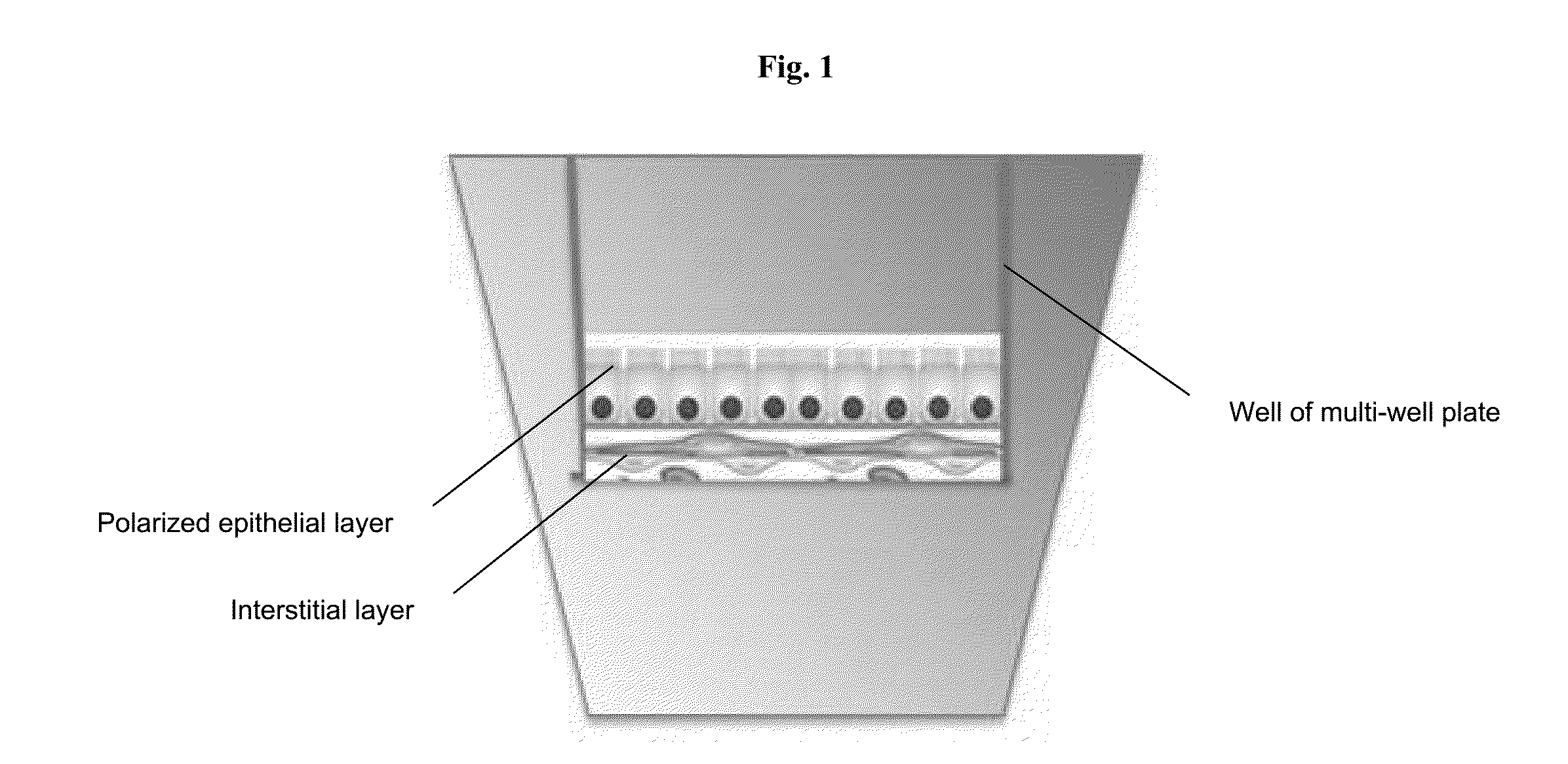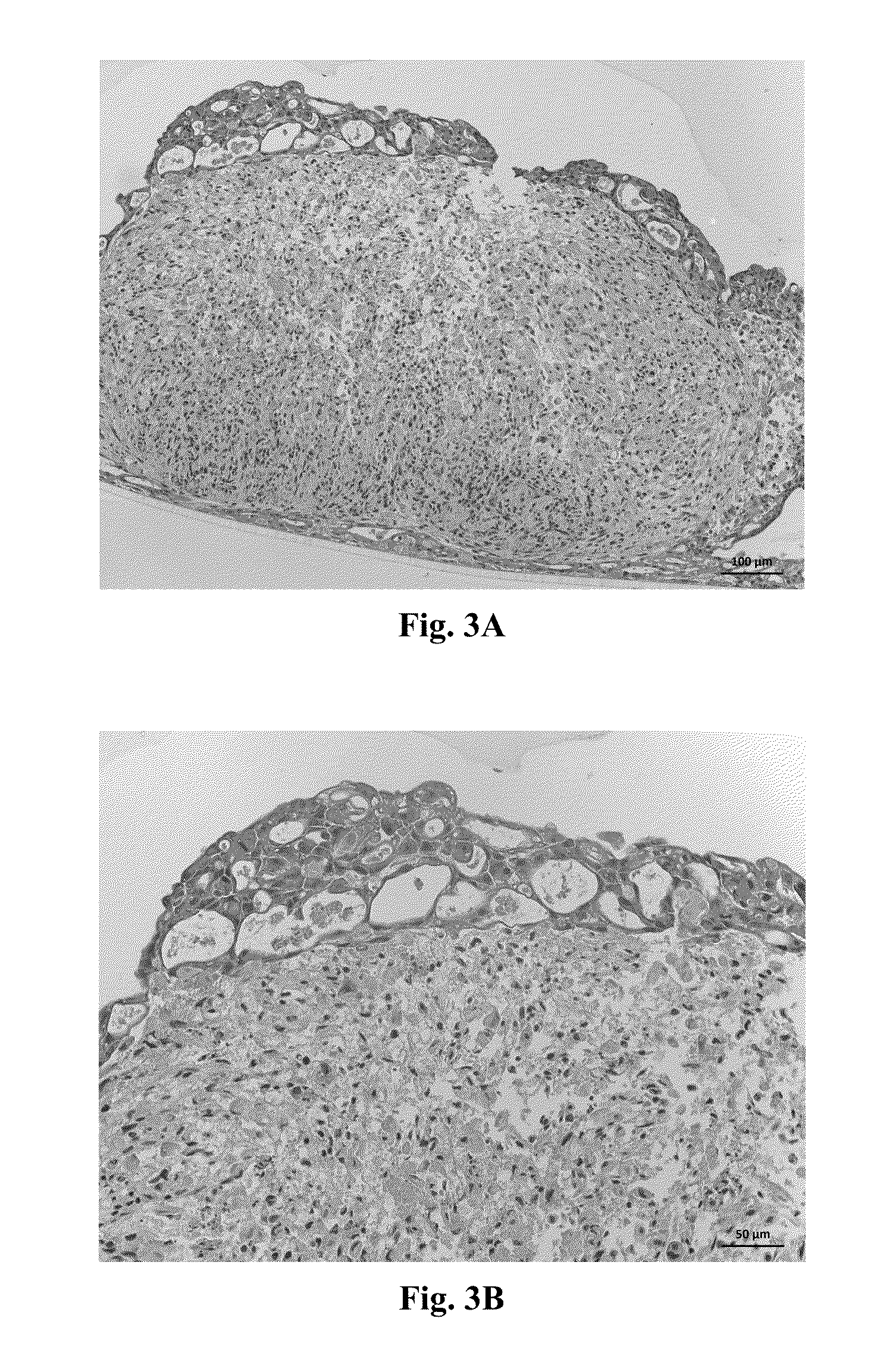Engineered renal tissues, arrays thereof, and methods of making the same
- Summary
- Abstract
- Description
- Claims
- Application Information
AI Technical Summary
Benefits of technology
Problems solved by technology
Method used
Image
Examples
example 1
A Bioprinted Three-Dimensional Renal Tubule Cell Model
[0099]A 3-layer cup shape with dimensions 3 mm×3 mm×0.75 mm was bioprinted onto a Transwell membrane in a 12-well tissue culture plate (FIGS. 2A and 2B). The bottom sheet and two layered walls were composed of 75% adult renal fibroblasts (aRF) and 25% human umbilical vein endothelial cells (HUVEC). The cells were resuspended at 150 million cells / ml in Novogel® 2.0. The cup was filled with a dilute suspension of 100% epithelial cells (MDCK) at 1-5 million cells / ml in 2% gelatin (“Structure 1”). Immediately following bioprinting, structures were surrounded with molten Novogel® 1.0 and were then cultured in a mixture of renal fibroblasts media, HUVEC media, and MDCK media.
[0100]Assessment of Structure 1 was performed by histological staining for cell-type specific markers. A representative H&E stain for Structure 1 is shown in FIGS. 3A and 3B. Constructs were stained for CD31 and TE7 to assess the relative positions of the HUVEC cel...
example 2
A Bioprinted Three-Dimensional Renal Tubule Cell Model
[0101]A sheet with dimensions 3 mm×3 mm×250 μm was bioprinted onto a Transwell membrane in a 12-well plate. The tissue sheet was composed of 75% adult renal fibroblasts and 25% HUVEC resuspended at 150 million cells / ml in Novogel® 2.0. The edges of the sheet were bordered by a 500 μm thick bioprinted hydrogel-only wall composed of Novogel® 3.0. Immediately following bioprinting, the boundary wall was crosslinked with 50 mM calcium chloride for 2 minutes. This solution was then aspirated and the constructs were surrounded with molten Novogel® 1.0. A dilute suspension of epithelial cells (MDCK or hTERT-RPTEC) at 1 million cells / ml was then added to the top surface of the structure by deposition using an inkjet spray module set with a 100 ms valve open time (“Structure 2”). A schematic of Structure 2 is shown in FIGS. 6A and 6B. Use of the inkjet spray module allows for deposition of epithelial cells immediately after printing or in...
example 3
A Bioprinted Three-Dimensional Renal Tubule Cell Model
[0103]To reduce the thickness and cellularity of the interstitial layer, the cell ratio was changed to 50% fibroblasts / 50% HUVEC the concentration of the cells was 1.25×108 cells / mL. The interstitial layer of the renal proximal tubule model is composed of renal fibroblasts and HUVECs in Novogel® 2.0. Constructs produced in this example show proximal tubule epithelial cells (RPTECs) in 3D renal tissues that exhibit features of polarization. E-cadherin (green) at the lateral membranes between RPTECs corresponds to tight junctions (FIGS. 9A, B and C). Further, the basement membrane corresponding to the interstitial layer produces collagen (FIGS. 9 A and B; stained with red). H & E staining is shown (FIG. 10A), and brush borders are indicated (FIG. 11A, arrows). Trichrome staining indicates collagen secretion (FIGS. 10B, blue and 11B, arrows), and CD31 staining indicates the presence of HUVEC networks (FIG. 12, asterisks). Bioprinted...
PUM
 Login to View More
Login to View More Abstract
Description
Claims
Application Information
 Login to View More
Login to View More - R&D
- Intellectual Property
- Life Sciences
- Materials
- Tech Scout
- Unparalleled Data Quality
- Higher Quality Content
- 60% Fewer Hallucinations
Browse by: Latest US Patents, China's latest patents, Technical Efficacy Thesaurus, Application Domain, Technology Topic, Popular Technical Reports.
© 2025 PatSnap. All rights reserved.Legal|Privacy policy|Modern Slavery Act Transparency Statement|Sitemap|About US| Contact US: help@patsnap.com



